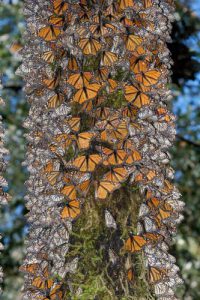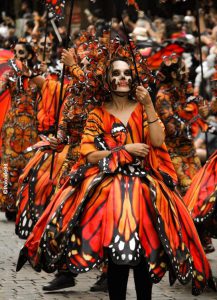
Pilgrimages have taken place for millennia, all over the world. The purpose may be a spiritual quest or a desire to reconnect with some historic location, but the draw to special places is an ancient one for the human species.
So also, it seems, for monarch butterflies, flitting far above the earth like jagged pieces of stained glass brought to life. These creatures take the longest migration of any member of the vast insect class. Driven to a place they’ve never been by magnetic forces and a molecular-level compass mechanism situated in their antennae, tens of millions of monarch butterflies leave Canada and the eastern United States to overwinter in Mexican forests every year. After bulking up on nectar in the summer and early fall, butterflies may fly for 11 hours straight before taking a break to feed again. Depending on their origin, they may fly over the entire Gulf of Mexico (up to 900 miles), while others make a cross-continental journey of nearly 2500 miles.

The densest congregation of monarchs is in the Sierra Madre Mountains, particularly the state of Michoacán. Here, a single generation of butterflies will overwinter for 4-5 months in the alpine oyamel fir forests, a cool, quiet place that offers plenty of space and little human interference. After leaving Mexico in the early spring, they will mate and start migrating back north, a process that takes 3-4 generations (including egg-laying, caterpillar growth, metamorphosis to adult) of butterflies (that live 4-6 weeks each) before landing in their spring and summertime homes.

Monarchs have been making this journey for so long that their arrival is integral to the local Mexican culture. Prehistoric stonework and paintings of indigenous people feature the butterfly. Migrating through the fall, the butterflies’ arrival typically coincides with the Dia de los Muertos (Day of the Dead) and All Saints (Nov. 1) and All Souls’ (Nov. 2) days, and has therefore been integrated into these celebrations. Sacred times for honoring the dead, local legend is that the soaring butterflies are the souls of the dead floating back home. Families often decorate loved ones’ graves with lush flowers, attracting the butterflies in droves. Support of the monarchs’ dramatic pilgrimage, for local residents, is indeed spiritual and cultural experience, along with an act of environmental conservation.
Logging, climate change, and pesticides threaten monarch populations. Data published in the last few years has shown worldwide populations have dropped by 90%. To help, you can maintain healthy populations of native milkweed and nectar-producing flowers in your own yard, along with lending support to conservation organizations that conserve butterfly habitat.
 1
1
